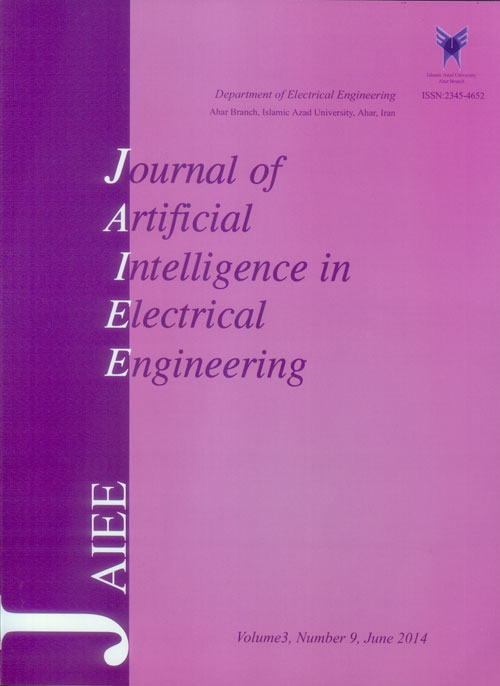فهرست مطالب

Journal of Artificial Intelligence in Electrical Engineering
Volume:3 Issue: 9, Spring 2014
- تاریخ انتشار: 1394/02/27
- تعداد عناوین: 6
-
Pages 1-11Increasing of word demand load caused a new Distributed Generation (DG) to enter to power system. One of the most renewable energy is the Photovoltaic System. It is beneficial to use this system in both separately as well as connected to power system using power electronics interface. In this paper an optimal PID controller for Photovoltaic System systems has been developed. The optimization technique is applied to PID optimal controller in order to control the voltage of Photovoltaic System against load variation, is presents. Nonlinear characteristics of load variations as plant input, Photovoltaic System operational behavior demand for high quality optimal controller to ensure both stability and safe performance. Thus, Honey Bee Mating Optimization (HBMO) is used for optimal tuning of PID coefficients in order to enhance closed loop system performance. In order to use this algorithm, at first, problem is written as an optimization problem which includes the objective function and constraints, and then to achieve the most desirable controller, HBMO algorithm is applied to solve the problem. In this study, the proposed controller is applied to the closed loop photovoltaic system behavior. Simulation results are done for various loads in time domain, and the results show the efficiency of the proposed controller in contrast to the previous controllers.Keywords: Photovoltaic System, HBMO, Optimal Controller, PID Controller
-
Pages 12-17Due to high speed computer networks, the use of digitally formatted data has increased many folds. The digital data can be duplicated and edited with great ease which has led to a need for effective copyright protection tools. Digital Watermarking is a technology of embedding watermark with intellectual property rights into images, videos, audios and other multimedia data by a certain algorithm. Digital watermarking is a well-known technique used for copy rights protection of multimedia data. A number of watermarking techniques have been proposed in literature. Digital Watermarking is the process that embeds data called a watermark into a multimedia object such that watermark can be detected or extracted later to make an assertion about the object. A variety of techniques in different domains have been suggested by different authors to achieve above mentioned conflicting requirements. All the watermarking techniques are different from each other and are used for differing applications.Keywords: Watermarking, Domain, DCT, DWT
-
Pages 18-26The purpose of load frequency control is to reduce transient oscillation frequencies than its nominal value and achieve zero steady-state error for it.A common technique used in real applications is to use the proportional integral controller (PI). But this controller has a longer settling time and a lot of Extra mutation in output response of system so it required that the parameters be adjusted as appropriate. In this paper, we aim to design a system based on PI controllers using improved particle swarm optimization algorithm for load frequency control. Multi-population approach and local search to improve the optimization algorithms is used and displayed. That this approach will lead to accelerating the achievement of results, preventing entrapment in a local minimum, and get better system output compared with similar methods.Keywords: Load Frequency Control, proportional integral control, improved particle swarm optimization algorithm
-
Pages 27-33This paper mainly focused on implementation of AES encryption and decryption standard AES- 128. All the transformations of both Encryption and Decryption are simulated using an iterative design approach in order to minimize the hardware consumption. This method can make it a very low-complex architecture, especially in saving the hardware resource in implementing the AES InverseSub Bytes module and Inverse Mix columns module. As the S -box is implemented by look-up-table in this design, the chip area and power can still be optimized. The new Mix Column transformation improves the performance of the inverse cipher and also reduces the complexity of the system that supports the inverse cipher. As a result this transformation has relatively low relevant diffusion power. This allows for scaling of the architecture towards vulnerable portable and cost-sensitive communications devices in consumer and military applications.Keywords: AES, encryption, decryption, FPGA
-
Pages 34-45In this paper, a novel approach for two-loop control of the DC-DC Ćuk converter in discontinuous conduction mode is presented using a sliding mode controller. The proposed controller can regulate the output of the converter in a wide range of input voltage and load resistance. Controller parameters are selected using PSO algorithms. In order to verify the accuracy and efficiency of the developed sliding mode controller, the proposed method is simulated in MATLAB/Simulink. It is shown that the developed controller has, the faster dynamic response compared with standard integrated circuit (MIC38C42-5) based regulators.Keywords: sliding mode controller, steady, state error, a double, loop controller, inductor current sampling, Particle Swarm Optimization (PSO), discontinuous conduction mode
-
Pages 46-53Short term load forecasting (STLF) plays an important role in the economic and reliable operation of power systems. Electric load demand has a complex profile with many multivariable and nonlinear dependencies. In this study, recurrent neural network (RNN) architecture is presented for STLF. The proposed model is capable of forecasting next 24-hour load profile. The main feature in this network is internal feedback to highlight the effect of past load data for efficient load forecasting results. Testing results on the three year demand profile shows higher performance with respect to common feed forward back propagation architecture.Keywords: Short term load forecasting (STLF), Recurrent neural network (RNN), hourly load forecast, Load Data normalization

